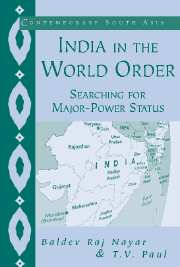Book contents
- Frontmatter
- Contents
- Acknowledgements
- 1 Introduction: India and Its Search for a Major-Power Role
- 2 Major-Power Status in the Modern World: India in Comparative Perspective
- 3 The Constraints on India: International and Domestic
- 4 Nehru's Grand Strategy for a Major-Power Role, 1947—1964
- 5 Strategy in Hard Times: The Long March for Capabilities, 1964—1990
- 6 After the Cold War: Adaptation, Persistence and Assertion, 1991—2001
- 7 Conclusions: India and the Emerging International Order
- Bibliography
- Index
3 - The Constraints on India: International and Domestic
Published online by Cambridge University Press: 05 July 2014
- Frontmatter
- Contents
- Acknowledgements
- 1 Introduction: India and Its Search for a Major-Power Role
- 2 Major-Power Status in the Modern World: India in Comparative Perspective
- 3 The Constraints on India: International and Domestic
- 4 Nehru's Grand Strategy for a Major-Power Role, 1947—1964
- 5 Strategy in Hard Times: The Long March for Capabilities, 1964—1990
- 6 After the Cold War: Adaptation, Persistence and Assertion, 1991—2001
- 7 Conclusions: India and the Emerging International Order
- Bibliography
- Index
Summary
The rise of a new state to the status of a major power has invariably been turbulent. In fact, almost all of the present-day major powers have achieved their status through victory in war with other major powers. Major-power status is often accorded to the leading members of a winning coalition in a postwar settlement. All the current major powers, or the five permanent members of the UN Security Council (the P–5), were in such a coalition at the end of World War II. Although China was not a leading member in this coalition, it was part of the war against the Axis powers and was accorded the status due to US insistence. The major-power system has, however, been frozen since 1945, and with no third world war in sight it may remain so in the foreseeable future. As discussed in the previous chapter, India, with its subcontinental size, large population, economic and military strength, leadership role among the developing countries, and diplomatic activism at the UN and other international forums, is indeed the strongest contender for future major-power status among all the potential candidates from the developing world. In the developed world, Germany and Japan remain strong contenders, but several structural, normative and institutional factors act as constraints on their projecting or actively asserting their position in the short and medium terms.
- Type
- Chapter
- Information
- India in the World OrderSearching for Major-Power Status, pp. 65 - 114Publisher: Cambridge University PressPrint publication year: 2002



